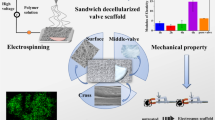Abstract
In this paper, a novel combination method of electrospinning and rapid prototyping (RP) fused deposition modeling (FDM) is proposed for the fabrication of a tissue engineering heart valve (TEHV) scaffold. The scaffold preparation consisted of two steps: tri-leaflet scaffold fabrication and heart valve ring fabrication. With the purpose of mimicking the anisotropic mechanical properties of the natural heart valve leaflet, electrospun thermoplastic polyurethane (ES-TPU) was introduced as the tri-leaflet scaffold material. ES-TPU scaffolds can be fabricated to have a well-aligned fiber network, which is important for applications involving mechanically anisotropic soft tissues. We developed ES-TPU scaffolds as heart valve leaflet materials under variable speed conditions and measured fiber alignment by fast Fourier transform (FFT). By using FFT to assign relative alignment values to an electrospun matrix, it is possible to systematically evaluate how different processing variables affect the structure and material properties of a scaffold. TPU was suspended at certain concentrations and electrospun from 1,1,1,3,3,3-hexafluoro-2-propanol onto rotating mandrels (200–3000 rpm). The scaffold morphological property and mechanical anisotropic property are discussed in the paper as a function of fiber diameter and mandrel RPM. The induction of varying degrees of anisotropy imparted distinctive material properties to the electrospun scaffolds. A dynamic optimum design of the heart valve ring graft was constructed by FDM. Fabrication of a 3D heart valve ring was constructed using pro-engineer based on optimum hemodynamic analysis and was converted to an STL file format. The model was then created from PCL which was sewed and glued with electrospun nanofibrous leaflets. This proposed method was proven as a promising fabrication process in fabricating a specially designed graft with the correct physical and mechanical properties.
Similar content being viewed by others
References
Brody S, Pandit A. Approaches to heart valve tissue engineering scaffold design. Journal of Biomedical Materials Research - Part B Applied Biomaterials, 2007, 83(1): 16–43
Rosamond W, Flegal K, Furie K, et al. Heart disease and stroke statistics — 2008 update: a report from the American Heart Association Statistics Committee and Stroke Statistics Subcommittee. Circulation, 2008, 117(4)
Kidane A G, Burriesci G, Cornejo P, et al. Current developments and future prospects for heart valve replacement therapy. Journal of Biomedical Materials Research - Part B Applied Biomaterials, 2009, 88(1): 290–303
Langer R, Vacanti J P. Tissue engineering. Science, 1993, 260 (5110): 920–926
Weinand C, Pomerantseva I, Neville C M, et al. Hydrogel-beta-TCP scaffolds and stem cells for tissue engineering bone. Bone, 2006, 38(4): 555–563
Takagi K, Fukunaga S, Nishi A, et al. In vivo recellularization of plain decellularized xenografts with specific cell characterization in the systemic circulation: Histological and immunohistochemical study. Artificial Organs, 2006, 30(4): 233–241
Martina M, Subramanyam G, Weaver J C, et al. Developing macroporous bicontinuous materials as scaffolds for tissue engineering. Biomaterials, 2005, 26(28): 5609–5616
Masood S H, Singh J P, Morsi Y. The design and manufacturing of porous scaffolds for tissue engineering using rapid prototyping. International Journal of Advanced Manufacturing Technology, 2005, 27(3–4): 415–420
Landers R, Hübner U, Schmelzeisen R, et al. Rapid prototyping of scaffolds derived from thermoreversible hydrogels and tailored for applications in tissue engineering. Biomaterials, 2002, 23(23): 4437–4447
Landers R, Pfister A, Hübner U, et al. Fabrication of soft tissue engineering scaffolds by means of rapid prototyping techniques. Journal of Materials Science, 2002, 37(15): 3107–3116
Zong X H, Kim K, Fang D F, et al. Structure and process relationship of electrospun bioabsorbable nanofiber membranes. Polymer, 2002, 43(16): 4403–4412
Webster T J, Waid M C, McKenzie J L, et al. Nano-biotechnology: carbon nanofibres as improved neural and orthopaedic implants. Nanotechnology, 2004, 15(1): 48–54
Pedicini A, Farris R J. Mechanical behavior of electrospun polyurethane. Polymer, 2003, 44(22): 6857–6862
Tatai L, Moore T G, Adhikari R, et al. Thermoplastic biodegradable polyurethanes: The effect of chain extender structure on properties and in-vitro. Biomaterials, 2007, 28: 5407–5417
Huang Z M, Zhang Y Z, Ramakrishna S, et al. Electrospinning and mechanical characterization of gelatin nanofibers. Polymer, 2004, 45(15): 5361–5368
Author information
Authors and Affiliations
Corresponding author
Rights and permissions
About this article
Cite this article
Chen, R., Morsi, Y., Patel, S. et al. A novel approach via combination of electrospinning and FDM for tri-leaflet heart valve scaffold fabrication. Front. Mater. Sci. China 3, 359–366 (2009). https://doi.org/10.1007/s11706-009-0067-3
Received:
Accepted:
Published:
Issue Date:
DOI: https://doi.org/10.1007/s11706-009-0067-3




